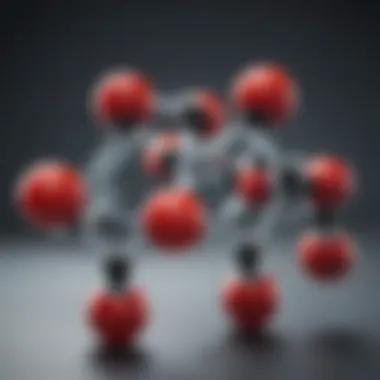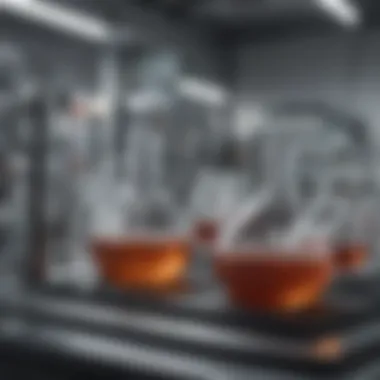Iodoacetic Acid: Properties, Applications, and Implications


Intro
Iodoacetic acid is a chiral compound with a considerable place in both chemical and biological research. Its distinct attributes make it a subject of inquiry in various scientific domains. This article aims to unpack the complexity of iodoacetic acid by exploring its molecular structure, physical and chemical properties, synthesis methods, and a wide array of applications. Additionally, it addresses its effects on biological systems and discusses the safety and environmental implications. By providing clarity on these matters, this article serves audiences ranging from students and educators to professional researchers.
Key Concepts
Definition of the Main Idea
Iodoacetic acid is an organoiodine compound recognized for its role as a reagent and a biological tool. Its formula is C2I2O2, and it features an acetic acid moiety where a hydrogen atom is replaced by iodine. This simple substitution bestows it with significant reactivity and utility in laboratories.
Understanding iodoacetic acid involves looking at its various applications—both in synthetic chemistry and biochemistry. It acts as an irreversible inhibitor of certain enzymes and is utilized in various research fields.
Overview of Scientific Principles
Iodoacetic acid exhibits distinctive physicochemical properties that contribute to its functionality. Some core attributes include:
- Molecular Weight: iodoacetic acid has a molecular mass of about 215.93 g/mol.
- Solubility: It is moderately soluble in water and organic solvents.
- Density: The density of this acid is approximately 1.825 g/cm³.
From a regulatory perspective, it is imperative to consider the effects of iodoacetic acid on biological systems. For instance, its mode of action chiefly revolves around forming covalent bonds with thiol groups in proteins, which can disrupt normal cellular functions.
Current Research Trends
Recent Studies and Findings
Iodoacetic acid has gained attention in several recent studies focusing on its applications across different domains. Some notable areas include drug development, enzyme inhibition, and cancer research. New methodologies are being developed to utilize its reactive nature to create more specific and potent chemical agents.
Significant Breakthroughs in the Field
Recent breakthroughs have emphasized the potential of iodoacetic acid as a therapeutic agent. For instance, research has shown its utility in inducing apoptosis in certain cancer cell lines. Such findings are pushing forward the search for novel cancer treatments and underscore the importance of understanding iodoacetic acid's biological impact.
"Iodoacetic acid's application in biological research varies from enzyme inhibition to potential drug development, making it a compound of utmost relevance."
"Iodoacetic acid's application in biological research varies from enzyme inhibition to potential drug development, making it a compound of utmost relevance."
Foreword to Iodoacetic Acid
Iodoacetic acid is a significant compound in various fields of scientific research, particularly within biochemistry and organic chemistry. Its relevance extends to multiple applications that aid in the understanding of complex biological systems. One of the primary benefits of studying iodoacetic acid lies in its role as an inhibitor in enzyme studies, which provides insights into metabolic processes. Additionally, this compound serves as a useful reagent for synthesizing other chemical compounds.
Understanding the properties, applications, and implications of iodoacetic acid enriches discussions on safety and environmental concerns related to its use.
Definition and Overview
Iodoacetic acid is a halogenated acetic acid derivative, with the chemical formula C2I2O2. The molecular structure includes an iodine atom attached to the acetic acid molecule. Its chemical properties are defined by this composition, which includes its reactivity and solubility characteristics. As a compound, it has various roles in both laboratory research and industrial applications.
Historical Context
The discovery and synthesis of iodoacetic acid date back to the early 20th century. Initial studies focused on its potential as a pharmacological agent. Over time, researchers observed its effects on biological systems, particularly in the inhibition of specific enzymes. This observation directed further investigation into its mechanisms and pathways in cellular functions. The historical perspective highlights how the understanding of iodoacetic acid has evolved, leading to ongoing research and new applications.
"The journey of iodoacetic acid from a simple organic compound to an essential reagent reflects its remarkable versatility in scientific inquiry."
"The journey of iodoacetic acid from a simple organic compound to an essential reagent reflects its remarkable versatility in scientific inquiry."
Today, iodoacetic acid continues to captivate researchers, maintaining its importance across several scientific domains.
Chemical Structure and Properties


Understanding the chemical structure and properties of iodoacetic acid is crucial for grasping its applications and implications in various fields. This section provides insight into its molecular composition and the physicochemical properties that make it a notable compound in both research and industrial settings.
Molecular Composition
Iodoacetic acid has a simple but distinctive molecular formula: C2I02. This formula reveals two key components: carbon atoms, which are central to its structure, and iodine, which imparts unique functionalities. The presence of iodine, in particular, creates a polar bond, influencing solubility and reactivity.
The molecular weight is approximately 151.94 g/mol, which contributes to its overall behavior in chemical reactions. The arrangement of atoms within the molecule is significant as well; the carboxyl group (-COOH) plays a vital role in the acid's properties.
Physicochemical Properties
The physicochemical properties of iodoacetic acid can greatly influence its utility in different applications. These properties include solubility characteristics, melting and boiling points, and its acidic nature. Each aspect contributes unique benefits and considerations.
Solubility Characteristics
Iodoacetic acid exhibits interesting solubility characteristics. It is soluble in water, alcohols, and ether while showing low solubility in non-polar solvents. This behavior is fundamental because it allows for effective incorporation into aqueous solutions for biological studies. The polar nature of the molecule enhances its interaction with water, making it an efficient choice for conducting experiments related to enzyme inhibition or other biochemical processes.
That being said, its high solubility in water can also pose challenges in terms of stability and potential reactivity. Careful handling is essential when using iodoacetic acid in various applications to avoid unintended reactions.
Melting and Boiling Points
Iodoacetic acid has a melting point of approximately 100 °C and a boiling point around 184 °C. These temperature characteristics indicate that it is a solid at room temperature, transitioning into a liquid when heated. The melting point is particularly relevant since it influences how iodoacetic acid can be stored and utilized in different environments.
Higher boiling points often indicate stability under heat, which is beneficial in industrial processes where prolonged exposure to temperature variations may occur.
However, users must be aware that differing conditions, such as pressure variations, can affect these values and subsequently affect their practical usage.
Acidic Nature
Iodoacetic acid is classified as a weak acid, which has implications for its reactivity with different compounds. The acidic nature reflects its capability to donate protons in reactions, playing an important role in biological interactions. This property is valuable in enzyme inhibition studies where the acid can selectively inhibit specific enzymes, leading to insights in metabolic pathways.
The acidic characteristic, while advantageous in myriad applications, may also require a careful approach in data interpretation, especially when mixed with other reactive substances. The balance between its reactivity and stability remains an important consideration in any experimentation involving iodoacetic acid.
"The fundamental understanding of chemical structure and properties is a gateway to exploring the various applications of iodoacetic acid in research and industry."
"The fundamental understanding of chemical structure and properties is a gateway to exploring the various applications of iodoacetic acid in research and industry."
In summary, the chemical structure and various physicochemical properties of iodoacetic acid collectively underline its versatility in scientific research and its importance in industrial applications.
Synthesis of Iodoacetic Acid
The synthesis of iodoacetic acid presents a crucial element in understanding both its practical applications and theoretical implications. This section highlights the significance behind developing methods for generating this compound. Knowledge of synthesis forms the foundation for its use in various fields including biochemistry and pharmaceuticals. The benefits of efficient synthesis methods include high yield, improved purity, and cost-effectiveness. Understanding synthesis can also facilitate the exploration of novel applications of iodoacetic acid.
Chemical Reactions for Synthesis
Direct Synthesis Methods
Direct synthesis methods are widely employed for the preparation of iodoacetic acid. This approach typically involves the reaction of acetic acid with iodine. A notable characteristic of direct methods is their simplicity and ease of execution. The straightforward reaction continues to benefit researchers by minimizing the steps needed for product formation.
Using direct methods often leads to significant cost savings, making it an attractive choice in laboratories focused on organic synthesis. However, potential disadvantages include the formation of unwanted by-products which may complicate subsequent purification steps.
Alternative Routes
Alternative routes for synthesizing iodoacetic acid often involve different starting materials or more complex reaction pathways. For instance, Wang and others have demonstrated how derivatives of acetic acid can lead to the target compound through various chemical reactions. This method can be particularly beneficial when specific reactions are not feasible via direct methods.
A key characteristic of alternative routes is their potential to enhance yield and selectivity towards iodoacetic acid. These routes often offer innovative approaches to resolve issues found in direct methods. However, they may come with increased complexity and require additional steps that could negatively affect the overall efficiency of the production.
Purification Techniques
Proper purification techniques are integral to ensuring the obtained iodoacetic acid meets the high standards required for research and application. Common methods include recrystallization and chromatography, both of which are aimed at improving the purity of the final product.
Recrystallization relies on the solubility differences of compounds to separate desired products from impure mixtures. Meanwhile, chromatography offers a versatile technique to separate and identify components based on their movement through a stationary phase.
Utilizing comprehensive purification strategies not only increases the quality of the iodoacetic acid but also accelerates its adoption in diverse scientific fields.
Biological Applications of Iodoacetic Acid


Iodoacetic acid stands out in the field of biochemistry due to its significant role in various biological applications. Its varied uses stem from its capacity to modulate enzymatic activity and influence cellular mechanisms. Understanding these applications is crucial for researchers and professionals involved in biotechnology, pharmacology, and related fields. By comprehending how iodoacetic acid interacts with biological systems, one can appreciate its importance in scientific research and potential therapeutic developments.
Enzyme Inhibition Studies
The enzyme inhibition properties of iodoacetic acid have garnered considerable interest. This compound effectively inhibits certain enzymes involved in metabolic processes. For instance, it is known to interact with glyceraldehyde 3-phosphate dehydrogenase, an enzyme crucial for glycolysis. By inhibiting this enzyme, iodoacetic acid disrupts normal glucose metabolism, making it a useful tool in experimental studies designed to understand metabolic pathways.
Another significant aspect of enzyme inhibition studies with iodoacetic acid lies in its ability to serve as a competitive inhibitor. This allows researchers to dissect the enzyme kinetics with precision. Typically, understanding the concentration of iodoacetic acid and its effect on enzyme activity can lead to critical insights into metabolic dysregulations.
Mechanisms of Action
Iodoacetic acid exerts its biological effects primarily through specific mechanisms of action. One of the key mechanisms involves the modification of cysteine residues in enzymes. By forming adducts with these residues, iodoacetic acid alters the enzyme’s structure and function. This modification leads to a decrease in enzymatic activity, which has implications for cellular energy production.
Furthermore, the effects of iodoacetic acid are not limited to single enzymes. Its actions can cause a cascade of events affecting entire metabolic pathways. For example, by disrupting glycolysis, the compound impacts the generation of ATP, leading to altered cellular functions across various tissues.
In studying these mechanisms, researchers can explore both pharmacological applications and the impact of iodoacetic acid on disease states, particularly in cancer research where altered metabolic pathways are a hallmark.
Iodoacetic acid serves as a critical tool in elucidating metabolic processes, demonstrating its value in both laboratory and clinical research settings.
Iodoacetic acid serves as a critical tool in elucidating metabolic processes, demonstrating its value in both laboratory and clinical research settings.
Industrial Applications
Iodoacetic acid has gained prominence across various industrial settings in recent decades. Its unique properties lend themselves to diverse applications, particularly in organic synthesis and pharmaceuticals. Understanding these industrial roles is crucial for anyone involved in chemical research or industry.
Role in Organic Synthesis
One of the primary industrial applications of iodoacetic acid lies in its capacity as a reagent in organic synthesis. Its ability to form covalent bonds with nucleophiles positions it as a valuable building block in the creation of more complex molecules. This is particularly relevant in the field of medicinal chemistry, where the synthesis of drug precursors often requires highly reactive halogenated compounds.
- Chemical Versatility: Its reactivity allows for the introduction of acetic acid moieties into target compounds. This versatility is essential when creating pharmaceuticals.
- Facilitating Reactions: Iodoacetic acid is often used to facilitate carbon-carbon bond formation. Through various reaction mechanisms, including nucleophilic substitution and addition, researchers can create molecules with desired functions.
- Efficiency in Synthesis: Using iodoacetic acid can lead to shorter reaction times and increased yields. This efficiency is crucial in industrial settings where time and resources significantly impact production costs.
The compound can also be utilized in designing inhibitors for specific enzymes. This sharpens its position in both research laboratories and industrial applications where targeted inhibition is sought.
Use in Pharmaceuticals
In the pharmaceutical industry, iodoacetic acid serves as an important intermediate in drug development. Its properties not only enhance the efficacy of the final products but also enable the creation of compounds with specific biological activities.
- Drug Development: Many drugs incorporate iodoacetic acid due to its influence on biological activity. By modifying side chains or functional groups, researchers can fine-tune pharmacological effects.
- Targeted Therapeutics: Iodoacetic acid's role in enzyme inhibition makes it suitable for developing targeted therapeutics, particularly in cancer treatments. The ability to inhibit specific metabolic pathways allows for more precise treatment options.
- Research and Innovation: Constant research efforts reveal new ways to utilize iodoacetic acid. Partnerships between academia and pharmaceutical firms frequently lead to discovering novel uses in various therapeutic areas.
"Iodoacetic acid has proven itself as an indispensable compound due to its broad applicability in both organic synthesis and pharmaceuticals, driving innovation and efficiency within these fields."
"Iodoacetic acid has proven itself as an indispensable compound due to its broad applicability in both organic synthesis and pharmaceuticals, driving innovation and efficiency within these fields."
Overall, the industrial applications of iodoacetic acid demonstrate its significance. From facilitating chemical syntheses to playing an essential role in pharmaceuticals, its impact resonates through numerous scientific and industrial advancements. The understanding of these applications expands along with ongoing research, revealing further possibilities for future innovations.
Safety and Toxicology Aspects
Safety and toxicology are crucial sections in any discussion about chemical compounds, including iodoacetic acid. Understanding these aspects helps in mitigating risks associated with handling the substance. It is vital to appreciate the toxicology of iodoacetic acid, primarily because it can have harmful effects on biological systems. Identifying the toxic properties can assist researchers and safety professionals in implementing appropriate measures for risk management.
Toxic Properties
Iodoacetic acid presents several toxicological concerns that are important to understand. Primarily, exposure to iodoacetic acid can result in cytotoxic effects. This compound can interfere with cellular metabolism, notably by inhibiting specific enzymes that are vital for energy production. A major toxic property to consider is its ability to induce cell death through apoptosis in certain cell types. The mechanism involves the inhibition of reactive acetylation, which is crucial for normal cellular function. Prolonged exposure can also lead to systemic toxicity, affecting multiple organ systems and potentially leading to severe health consequences.
Other toxic effects include irritation of mucous membranes and skin. Inhalation of dust or vapor can cause respiratory issues, including coughing and shortness of breath. Furthermore, ingestion of this compound can have fatal outcomes, highlighting the need for stringent safety measures. Therefore, it becomes essential to implement a thorough risk assessment protocol whenever iodoacetic acid is being utilized in a research or industrial context.
Handling and Storage Guidelines


Proper handling and storage of iodoacetic acid are paramount to ensure safety. Here are some guidelines to consider:
- Personal Protective Equipment (PPE): Always wear appropriate PPE, including gloves, goggles, and lab coats, when handling iodoacetic acid. This minimizes direct exposure to the skin and eyes.
- Ventilation: Conduct all experiments involving iodoacetic acid in a well-ventilated area or a fume hood. This reduces the risk of inhalation exposure to harmful vapors or dust.
- Storage: Store iodoacetic acid in a cool, dry place, away from light. Ensure that the storage area is well-ventilated, and use containers made of compatible materials to prevent chemical reactions.
- Labeling: Clearly label all containers holding iodoacetic acid with hazard symbols and appropriate handling instructions. This ensures that anyone interacting with the chemical is aware of its risks.
- Disposal: Follow local regulations for the disposal of iodoacetic acid. Do not dispose of it down the drain. Instead, consult material safety data sheets (MSDS) for proper disposal techniques.
By adhering to these safety considerations, professionals can reduce risks associated with iodoacetic acid, promoting a safer working environment.
Environmental Considerations
Environmental considerations regarding iodoacetic acid are essential for understanding its overall impact on ecosystems and human health. The usage and disposal of this compound require careful evaluation to mitigate potential adverse effects. As industries continue to employ iodoacetic acid in various applications, awareness of its environmental footprint becomes increasingly important.
Biodegradability
Biodegradability refers to the capacity of a substance to be broken down by microorganisms, thus minimizing its persistence in the environment. Iodoacetic acid poses concerns due to its stability and potential for accumulation. This stability, while beneficial in certain applications like research, can lead to challenges when it comes to environmental degradation.
Research indicates that iodoacetic acid does not readily degrade in natural environments. This raises alarm about its long-term presence in soil and water systems, where it may affect flora and fauna. Studies show that microbial activity can be limited with respect to this compound, thus preventing effective biodegradation. Such limitations underscore the necessity for rigorous assessments in environmental studies and regulatory frameworks governing the use of iodoacetic acid. Strategies to enhance biodegradability could be a focus for future research to mitigate these environmental challenges.
Regulatory Framework
The regulatory framework surrounding iodoacetic acid is crucial in ensuring that its use complies with safety and environmental standards. Various national and international agencies, including the Environmental Protection Agency (EPA) and the European Chemicals Agency (ECHA), have guidelines that assess the environmental risks associated with its usage.
Regulatory requirements typically encompass several aspects:
- Risk Assessment: Comprehensive evaluation of the compound's potential hazards to human health and the environment.
- Labeling and Safety Data Sheets: Clear guidelines dictate how products containing iodoacetic acid should be labeled to inform handling and usage.
- Monitoring and Reporting: Regular monitoring of iodoacetic acid levels in the environment to ensure compliance with legal limits.
Organizations engaged in research and industrial applications of iodoacetic acid must adhere to these regulations to avoid environmental contamination. The implementation of effective regulatory measures is critical, as it not only protects ecosystems but also promotes sustainable practices across industries.
"Understanding the environmental implications of synthetic compounds like iodoacetic acid is fundamental for fostering a balance between industrial benefits and ecological sustainability."
"Understanding the environmental implications of synthetic compounds like iodoacetic acid is fundamental for fostering a balance between industrial benefits and ecological sustainability."
Future Research Directions
Research into iodoacetic acid is a continually evolving field, crucial for advancing both biochemistry and pharmacology. The potential of this compound lies not only in its current applications but also in the possibilities that future investigations may reveal. Understanding these future research directions can illuminate pathways for innovation and optimization in multiple scientific domains.
Emerging Applications in Biochemistry
The role of iodoacetic acid in biochemistry is expanding. Researchers are investigating its capacity to influence metabolic pathways. Studies are ongoing to explore how this compound can modulate enzyme activity, potentially leading to breakthroughs in understanding various biochemical processes. For instance, iodoacetic acid's known ability as an enzyme inhibitor presents opportunities to study cellular respiration and energy metabolism with more depth.
Moreover, the characterization of its interactions with biomolecules can lead to innovative applications in synthetic biology. Researchers may harness these properties to design novel biological systems or therapeutic strategies. The insights gained from such studies will not only advance academic knowledge but could also enhance practical applications in agriculture, food sciences, and environmental biology.
Potential for New Pharmaceutical Developments
Iodoacetic acid shows promise beyond its existing pharmaceutical applications. One primary area of interest is its potential as a lead compound in drug development. Due to its competitive inhibition properties, it could serve as a scaffold for designing new drugs aimed at specific diseases, especially those related to metabolic disorders.
Further investigations on its structure-activity relationship might yield derivatives with improved efficacy and reduced toxicity. Collaborative efforts between chemists, biochemists, and pharmacologists are essential in this aspect, ensuring a multidisciplinary approach to drug development. The integration of computational methods and high-throughput screening can enhance the efficiency of discovering new therapeutic agents based on iodoacetic acid.
In summary, future research into iodoacetic acid is significant for numerous fields. Understanding emerging applications in biochemistry and exploring potential pharmaceutical developments can lead to innovative solutions to existing challenges in science and medicine. The implications of these studies extend broadly, providing a foundation for new strategies that address both fundamental and applied scientific inquiries.
End
Understanding the significance of iodoacetic acid is crucial within both the scientific community and industry. This compound is not only a key player in biochemical research, but it also plays an essential role in various applications, showing versatility across multiple fields.
Summary of Findings
The exploration of iodoacetic acid shows its relevance from numerous perspectives. Its chemical structure reveals a well-defined molecular composition which contributes to its behavior in various reactions. Furthermore, its physicochemical properties, such as solubility, melting, and boiling points, dictate how it interacts with other substances in both laboratory and industrial settings.
In terms of biological applications, iodoacetic acid serves as an important tool for enzyme inhibition studies. Its mechanisms of action are particularly meaningful for understanding intracellular processes and metabolic pathways. In industrial applications, iodoacetic acid finds its role primarily in organic synthesis and drug development, showcasing its practical benefits.
From a safety and environmental standpoint, the article emphasizes the toxic properties and handling guidelines necessary to mitigate risks associated with its use. Moreover, understanding its biodegradability and the regulatory framework surrounding its applications informs efforts to create safer and more sustainable practices in the industry.
Final Remarks on Iodoacetic Acid
As a final note, continued exploration into both the benefits and implications of this compound is necessary. Doing so will aid researchers in optimizing its use while ensuring minimal negative impacts on health and the environment.







